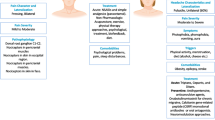Abstract
The question of whether tension-type headache (TTH) and migraine represent two points on a continuum has been debated for decades. Skeptics of the continuum model support their view by noting that the characteristics of these two headaches and the demographics of the individuals who suffer from them are undeniably distinct. In the clinical setting, however, these disorders exhibit more similarities than differences. TTH and migraine may exhibit similar associated features (even within the constraints of diagnostic criteria), respond effectively to similar medications, share similar demographics among certain age groups, and may each have genetic influences. These findings suggest that TTH and migraine may be more intimately related than would be suggested by their diagnostic criteria.
Similar content being viewed by others
References and Recommended Reading
Cady R, Schreiber C, Farmer K, Sheftell F: Primary headaches: a convergence hypothesis. Headache 2002, 42:204–216.
Rasmussen BK: Migraine and tension-type headache are separate disorders. Cephalalgia 1996, 16:217–219.
Silberstein SD: Historical aspects of headache. In Atlas of Migraine and Other Headaches, edn 2. Edited by Silberstein SD, Stiles MA, Young WB. London and New York: Taylor & Francis; 2005:15–16.
Couch JR, Ziegler DK, Hassanein RS: Evaluation of the relationship between migraine headache and depression. Headache 1975, 15:41–50.
Featherstone HJ: Migraine and muscle contraction headaches: a continuum. Headache 1985, 25:194–198.
Headache Classification Subcommittee: The International Classification of Headache Disorders. Cephalalgia 2004, 24(Suppl 1):9–160.
Olesen J: The International Classification of Headache Disorders. Headache 2008, 48:691–693.
Goadsby PJ: Advances in the understanding of headache. Br Med Bull 2005, 73–74:83–92.
Rose G, Barker DJP: What is a case? Dichotomy or continuum? BMJ 1978, 2:873–874.
Lipton RB, Bigal ME, Diamond M, et al.: Migraine prevalence, disease burden, and the need for preventative therapy. Neurology 2007, 68:343–349.
Wöber C, Holzhammer J, Zeitlhofer J, et al.: Trigger factors of migraine and tension-type headache: experience and knowledge of the patients. J Headache Pain 2006, 7:188–195.
Schmidt-Wilcke T, Gänssbauer S, Neuner T, et al.: Subtle grey matter changes between migraine patients and healthy controls. Cephalalgia 2007, 28:1–4.
Schmidt-Wilcke T, Leinisch E, Straube A, et al.: Gray matter decrease in patients with chronic tension type headache. Neurology 2005, 65:1483–1486.
Goadsby PJ: Recent advances in the diagnosis and management of migraine. BMJ 2006, 332:25–29.
Brennum J, Brinck T, Scriver L, et al.: Sumatriptan has no clinically relevant effect in the treatment of episodic tension-type headache. Eur J Neurol 1996, 3:23–28.
Turkdogan D, Cagirici S, Soylemez D, et al.: Characteristic and overlapping features of migraine and tension-type headache. Headache 2006, 46:461–468.
Roh JK, Kim JS, Ahn YO: Epidemiologic and clinical characteristics of migraine and tension-type headache in Korea. Headache 1998, 38:356–365.
D’Amico D, Leone M, Bussone G: Side-locked unilaterality and pain localization in long-lasting headaches: migraine, tension-type headache, and cervicogenic headache. Headache 1994, 34:526–530.
Selby G, Lance JW: Observations on 500 cases of migraine and allied vascular headache. J Neurol Neurosurg Psychiatr 1960, 23:23–32.
Critchley M, Ferguson FR: Migraine. Lancet 1933, 221:123–126.
Ophoff RA, Terwindt GM, Vergouwe MN, et al.: Familial hemiplegic migraine and episodic ataxia type-2 are caused by mutations in the Ca2+ channel gene CACNL1A4. Cell 1996, 87:543–552.
De Fusco M, Marconi R, Silvestri L, et al.: Haploinsufficiency of ATP1A2 encoding the Na+/K+ pump alpha2 subunit associated with familial hemiplegic migraine type 2. Nat Genet 2003, 33:192–196.
Dichgans M, Freilinger T, Eckstein G, et al.: Mutation in the neuronal voltage-gated sodium channel SCN1A in familial hemiplegic migraine. Lancet 2005, 366:371–377.
Russel MB, Šaltyte-Benth J, Levi N: Are infrequent episodic, frequent episodic, and chronic tension-type headache inherited? A population based study of 11,199 twin pairs. J Headache Pain 2006, 7:119–126.
Lipton RB, Stewart WF, Cady R, et al.: Sumatriptan for the range of headaches in migraine sufferers: results of the spectrum study. Headache 2000, 40:783–791.
Miner JR, Smith SW, Moore J, et al.: Sumatriptan for the treatment of undifferentiated primary headaches in the ED. Am J Emerg Med 2007, 25:60–64.
Rasmussen BK, Jensen R, Schroll M, Olesen J: Epidemiology of headache in a general population: a prevalence study. J Clin Epidemiol 1991, 44:1147–1157.
Rasmussen BK, Jensen R, Schroll M, Olesen J: Interrelations between migraine and tension-type headache in the general population. Arch Neurol 1992, 49:914–918.
Klein P, Schomer DL: Effect of ovarian hormones on the nervous system. In Neurologic Diseases in Women, edn 2. Edited by Kaplan PW. New York: Demos Medical Publishing Inc; 2006:85–86.
Author information
Authors and Affiliations
Corresponding author
Rights and permissions
About this article
Cite this article
Vargas, B.B. Tension-type headache and migraine: Two points on a continuum?. Current Science Inc 12, 433–436 (2008). https://doi.org/10.1007/s11916-008-0073-7
Published:
Issue Date:
DOI: https://doi.org/10.1007/s11916-008-0073-7




